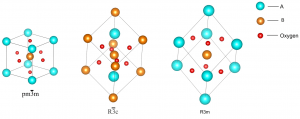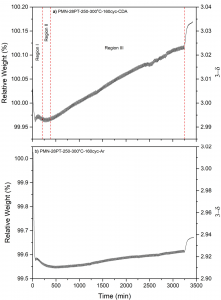The Phase Stability of Piezoelectric [(1-x)Pb(Mg1/3Nb2/3)O3]-xPbTiO3 (PMN-PT) Ceramics
PMN-PT single crystals provide outstanding piezoelectric properties, but they suffer from an electrical fatigue phenomenon. It deteriorates their piezo properties over long term usages and limits their applications. The focus of the research was on the phase stability of [(1-x)Pb(Mg1/3Nb2/3)O3]-xPbTiO3 (PMN-PT) piezoelectric single crystals and its dependence on oxygen partial pressures. A wide range of solid-state analytical techniques, including (in situ) Raman spectroscopy, (in situ) XRD, and calorimetry, has been deployed to examine subtle phase transition in PMN-PT from rhombohedral to cubic phases.
Fig 1. Schematic crystal cells for cubic (Pm-3m) and two rhombohedral (R ̅3̅ c and R3m) crystal symmetries with ABO3 perovskite structure.
(Please see the publication for further details)
The first step of the research reveals a high dependence of oxygen content in PMN-PT perovskites on oxygen partial pressure during heat treatments. It comes with changes in the weight of the materials.
Fig 2. The relative weight and the oxygen content (3-δ) changes of PMN-0.25PT sample A (250–300 °C-160 cycle under air).
(Please see the publication for further details)
Fig 3. Relative weight (left Y-axis) and oxygen content (right Y-axis) as functions of time for PMN-0.28PT sample during 160 thermocycles (250–300 °C) under a) and Compressed Dried Air (CDA) b) argon.
(Please see the publication for further details)
The next level of the investigation probes the correlation between the oxygen non-stoichiometry (δ) in the PMN-PT perovskite and phase transitions. (in situ) Raman Spectroscopy and (in situ) XRD on similar simulated conditions can detect changes in phase transition behavior corresponding to the observed weight loss/gain trends in TGA tests.
The research can suggest a new mechanism to explain the electrical fatigue phenomenon in PMN-PT piezoelectric ceramics. The findings show that the mechanism can be active at very low temperatures (<100°).




